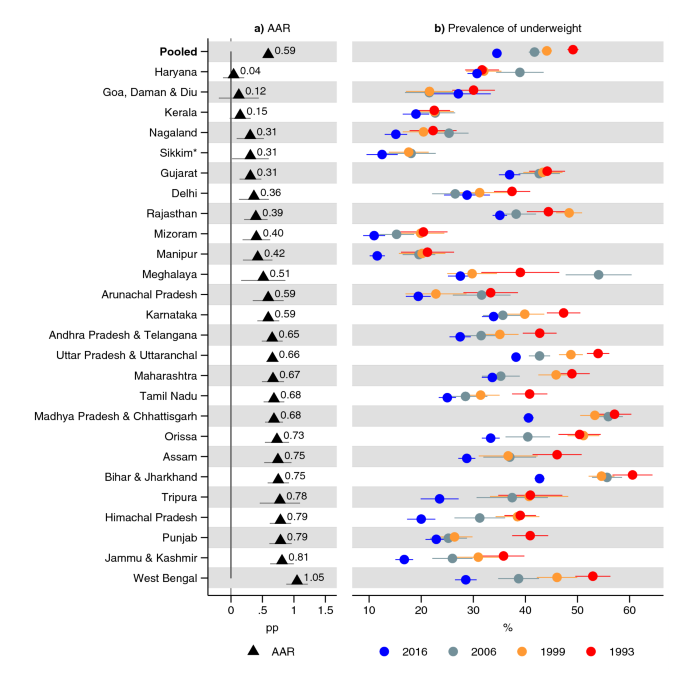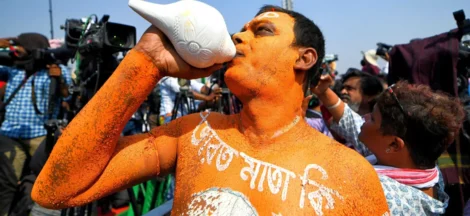By Dr. Gyan Pathak
New estimates show that thresholds of stunting and wasting of children in India under 5 years is very high at 31.7 per cent and 18.7 per cent respectively, against the global average of 22.3 and 6.8 per cent. In absolute term India had 36138100 stunted children in 2022, while the number of wasted children were 21880500 in 2020. There were 3181900 overweight children in 2022.
Though overweight threshold is low in India at 2.8 per cent, its rising trend in the last decade from 2.2 per cent in 2012 is a cause of additional concern, because it reveals exacerbating of this threat too. It may soon exceed the targeted level of 3 per cent by 2030, to which the world is trying to reduce from the present 5.6 per cent. India is thus under the grave triple threat of child malnutrition.
Levels and Trends in Child Malnutrition 2023, jointly released by UNICEF, WHO, and the World Bank, shows that stunting affected an estimated 22.3 per cent or 148.1 million children globally in 2022, while wasting threatened the lives of an estimated 6.8 per cent or 45 million children. Overweight affected an estimated 5.6 per cent or 37 million children under 5 years of age. If the present trend of reduction of stunting continues there would be 128.5 million children with stunting by 2030 as against the target of reducing it to 88.9 million.
Thus, the joint malnutrition estimate reveals insufficient progress to reach the 2025 World Health Assembly (WHA) global nutrition targets and the 2030 Sustainable Development Goal) 2 targets. Only about one third of all countries are ‘on track’ to have the number of children affected by stunting by 2030, with an assessment of progress to date not being possible for about one quarter of countries. Even fewer countries are expected to achieve the 2030 target of 3 per cent prevalence for overweight, with just 1 in 6 countries currently ‘on track’. Further, an assessment of progress towards wasting target is not possible for nearly half of countries.
In 2022, more than half (52 per cent) of all children under 5 affected by stunting lived in Asia and two out of five lived in Africa, for wasting these percentage are70 and 27, and for overweight 48 and 28 per cent respectively.
Number of countries with very high stunting prevalence has declined by 40 per cent since 2012 – from 46 to 28 countries. India is among the worst 28 countries in the world. Stunting level in this South Asia is 30.5 per cent as against India’s 31.7 per cent.
South Asia has the highest wasting prevalence of any sub-region in the world, with an average 14.3 per cent, while India’s wasting children were 18.7 per cent. Only one quarter of children under 5 live in this sub-region but it is home to more than half of all children with wasting in the world.
As for India is concerned, the present progress under the PM Modi’s rule is indicative of the fact that the country is neither going to overcome its double malnutrition threat – stunting and wasting –the children are reeling under, but the rising trend of the third threat of overweight will lead the country into the triple threat.
Though India has made a progress in the last decade in stunting reduction from 41.6 per cent (2012 value) to 31.7 per cent (2022 value), it is still unacceptably high, which is the result of the children not getting enough food and nutrition. As for wasting, the latest data is available for 2020 when it was at very high level at 18.7 per cent, which was almost triple the global average.
It should be noted that right to food is fundamental right in India, which is guaranteed by the Constitution and which is enforceable by virtue of the constitutional remedy under Article 32. Modi government therefore must be considered responsible for such a high rate of stunting of children.
Stunting is the devastating result of poor nutrition in-utero and early childhood. Children suffering from stunting may never attain their full possible height and their brains may never develop to their full cognitive potential. These children begin their lives at a marked disadvantage with consequences continuing into adulthood: they face learning difficulties in school, earn less as adults, and face barriers to participation in their communities.
Child wasting is the life-threatening result of poor nutrient intake and/or recurrent illnesses. Children suffering from wasting have weakened immunity, are susceptible to long-term developmental delays and face an increased risk of death, particularly when wasting is severe. Children suffering from severe wasting require early detection and timely treatment and care to survive.
All forms of malnutrition are preventable. To stop malnutrition before it starts, children and their families need access to nutritious diets, essential services and positive practices to set them on the path to survive and thrive. But today, these vital pathways to good nutrition are under growing threat, as many countries plunge deep into a global food and nutrition crisis fuelled by poverty, conflict, climate change and the enduring secondary effects of the COVID-19 pandemic. As the world responds to the crisis, urgent action is critical to protect maternal and child nutrition – especially in the most affected regions – and secure a future where the right to nutrition is a reality for every child. (IPA Service)




 New Parliament Building Inauguration By Prime Minister On Savarkar’s Birthday Has Significance
New Parliament Building Inauguration By Prime Minister On Savarkar’s Birthday Has Significance 